World History
The Thirty Years’ War was a series of wars, escalating from armed clashes of German princes to military confrontations involving all major European monarchs from 1618 to 1648. It was a crucial stage in the ongoing European wars of religion between Catholicism and Protestantism.
It was also the first civil war in continental Europe that mixed religious conflict with traditional princely territorial ambitions and emerging sentiments of national unity and transnational geopolitical balance of power.
In 1617, Ferdinand of Styria (1578–1637), the Habsburg heir apparent to the imperial throne of the Holy Roman Empire, was elected to be king of Bohemia. The Calvinists, the majority in Bohemia, revolted against their new Catholic king.
In May 1618, a group of Calvinist noblemen threw the two most hated Habsburg councilors from the Hradschin Castle’s window into a ditch, severely injuring both. This incident, termed the “defenestration of Prague,†put the Calvinists in temporary control over Bohemia and spread the religious conflict into surrounding principalities.
In 1619, Ferdinand succeeded to the throne of the Holy Roman Empire as Emperor Ferdinand II. In Bohemia, the Calvinists openly rejected Ferdinand as their king and offered the Crown to Frederick V of the Palatinate. In response, Ferdinand II secured support from the papacy and the Catholic kings of Spain and Poland and formed an alliance with Maximilian I, duke of Bavaria (1573–1651) and leader of the German Catholic League.
In November 1620, Catholic forces invaded Bohemia and defeated Frederick’s Union at the Battle of White Mountain. The Bohemian phase of the Thirty Years’ War ended with Catholic victory in 1623. Emperor Ferdinand recovered his Bohemian throne, and Maximilian acquired Palatinate after Frederick was deposed and his Union dissolved.
In 1625, as the triumphs of the Catholic forces enabled Ferdinand to restore centralized monarchical power over Austria and Bohemia, Christian IV (r. 1588–1648), Lutheran king of Denmark and duke of Holstein, intervened to rescue the German Protestants.
However, his army was no match for the Catholic League. Ferdinand secured assistance not only from Tilly, but also from Albrecht von Wallenstein, a Bohemian nobleman, who was a Lutheran by birth, then a converted Catholic, and now an ambitious mercenary with an eye on the Bohemian Crown lands.
After a series of military victories, Tilly and Wallenstein scattered the renegade German princes and compelled Christian IV to make peace in 1628. The Danish phase of the war ended again with Catholic victory. In 1629, Emperor Ferdinand issued the Edict of Restitution. The edict outlawed Calvinism, restored the former ecclesiastic territories to the Catholic Church, and restricted the right of legal appeal to the imperial diet by the Protestant princes.
The edict alienated the German Protestant princes. Meanwhile, the alliance between Spain and the Empire alarmed Lutheran king Gustavus Adolphus of Sweden (r. 1611–32) and King Louis XIII of France (r. 1610–43) and his chief minister, Armand-Jean du Plessis, duc and cardinal de Richelieu.
In the summer of 1630, the Swedish king, encouraged by the French Cardinal Richelieu and supported by the German Protestant princes, invaded Germany. After winning a few noteworthy battles in the early stage, he crushed Tilly’s Catholic League army in the battlefield at Breitenfeld in September of 1631.
Facing this defeat, Ferdinand was forced to turn to Wallenstein, who had been disgraced by the German Catholic powerhouses for his greedy and fast expansion of personal power. In November 1632, Wallenstein led his newly formed army, engaged the Swedish force at the Battle of Lutzen, and killed King Gustavus Adolphus on the battlefield. He then entered into a secret negotiation with the Swedes.
Because of his treachery, Ferdinand deprived him of his command and ordered his assassination in February 1634. The Swedish phase of the war ended with the Treaty of Prague of 1635, under which the Edict of Restitution was suspended and the Empire’s constitutional order was restored to pre-1618 conditions.
Louis XIII and his cardinal became increasingly disturbed by any possible settlement that would give the Habsburgs in Europe opportunities to mount attacks against France—from Spain in the south, the Netherlands in the north, and from a number of Habsburg territories in the east. A few days before the Treaty of Prague was finalized, France declared war on Spain. In retaliation, Spain invaded France and defeated Sweden, the French ally, at the Battle of Wittstock in 1636.
Meanwhile, the German Imperial armies, now combining the Catholics and the Protestants allied with a new sense of national unity, marched into France, forcing the French back in Alsace and Lorraine, ravaging Burgundy and Champagne, and threatening Paris. The French, supported by Dutch Protestants, carried out a few successful counterattacks but could not gain a clear advantage over the enemy.
However, the deaths of Emperor Ferdinand (1637), Cardinal Richelieu (1642), and Louis XIII (1643) gradually slowed down the momentum of the war, and both the new emperor Ferdinand III and the new cardinal Mazarin under the child king Louis XIV began to work toward a peace settlement in 1643.
The German people, after suffering from three decades of havoc of war, political treacheries, religious bloodshed, and economic devastation, had to live miserably for another fives years to see peace.
The Peace of Westphalia was finally reached in October 1648, composed of a set of treaties among the enemies in the Thirty Years’ War. It reorganized Germany into a very loose confederation with a unified diet and unified army.
The emperor remained in place symbolically as feudal overlord for the purpose of recognizing and protecting “German Liberties.†The peace legalized Calvinism, gave it equal status as Catholicism and Lutheranism, and recognized the rights of religious minorities in the electorates and principalities.
In short, the peace treaties announced little new but redrew a constitutional framework, which would guarantee a decentralized Germany for another two centuries. However, the territorial changes defined in the treaties did help the rise of Prussia to challenge the traditional authority of Habsburg Austria in the Holy Roman Empire.
In Europe, the peace marked the rapid decline of support for prolonging the ongoing wars of religion, and fresh sentiments of national unity, national interest, and national defense would gradually reshape European peoples and states. It also helped promote transnational cooperation and alliance.
The immediate consequences of the Thirty Years’ War in European geopolitics were the isolation and decline of Spain and the rise of France as the dominant power till the French Revolution at the end of the 18th century.
- Peace Of Augsburg
Peace of Augsburg The Peace of Augsburg refers to a settlement between Charles V, Holy Roman Emperor, and the Lutheran princes that accorded Lutheran churches legal status in Germany. This settlement resolved the conflict on a state level but did not...
- Holy Roman Empire
Holy Roman Empire During the period of 1500 to 1750, the Holy Roman Empire grew to be a large political entity but faced serious problems that brought it close to the point of disintegration. The immense territory of the empire—over 300 states...
- Louis Xiv
Louis XIVLouis XIV was born in 1638, the son of King Louis XIII and his wife, Anne of Austria, from the Habsburg dynasty. Anne served as regent until Louis XIV began to govern in his own name in 1651. However, he was carefully guided by Cardinal Jules...
- War Of The Spanish Succession
War of the Spanish Succession The War of the Spanish Succession (1701–14) was a great European conflict fought over which claimant would assume the vacant throne of Spain. Throughout the 16th century, Spain had been ruled by the Habsburg dynasty,...
- Vasa Dynasty
Vasa DynastyThe Swedish Vasa ruled Sweden directly from 1523 to 1654, and their descendants ruled through the female line until 1818. They also were kings of Poland 1587–1668. The people of Sweden had long resented the Union of Kalmar that had...
World History
Thirty Years’ War
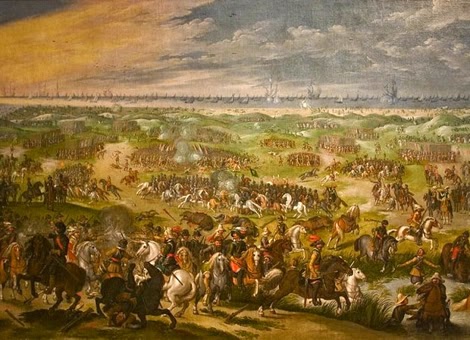 |
| Thirty Years’ War |
The Thirty Years’ War was a series of wars, escalating from armed clashes of German princes to military confrontations involving all major European monarchs from 1618 to 1648. It was a crucial stage in the ongoing European wars of religion between Catholicism and Protestantism.
It was also the first civil war in continental Europe that mixed religious conflict with traditional princely territorial ambitions and emerging sentiments of national unity and transnational geopolitical balance of power.
In 1617, Ferdinand of Styria (1578–1637), the Habsburg heir apparent to the imperial throne of the Holy Roman Empire, was elected to be king of Bohemia. The Calvinists, the majority in Bohemia, revolted against their new Catholic king.
In May 1618, a group of Calvinist noblemen threw the two most hated Habsburg councilors from the Hradschin Castle’s window into a ditch, severely injuring both. This incident, termed the “defenestration of Prague,†put the Calvinists in temporary control over Bohemia and spread the religious conflict into surrounding principalities.
In 1619, Ferdinand succeeded to the throne of the Holy Roman Empire as Emperor Ferdinand II. In Bohemia, the Calvinists openly rejected Ferdinand as their king and offered the Crown to Frederick V of the Palatinate. In response, Ferdinand II secured support from the papacy and the Catholic kings of Spain and Poland and formed an alliance with Maximilian I, duke of Bavaria (1573–1651) and leader of the German Catholic League.
 |
 |
In 1625, as the triumphs of the Catholic forces enabled Ferdinand to restore centralized monarchical power over Austria and Bohemia, Christian IV (r. 1588–1648), Lutheran king of Denmark and duke of Holstein, intervened to rescue the German Protestants.
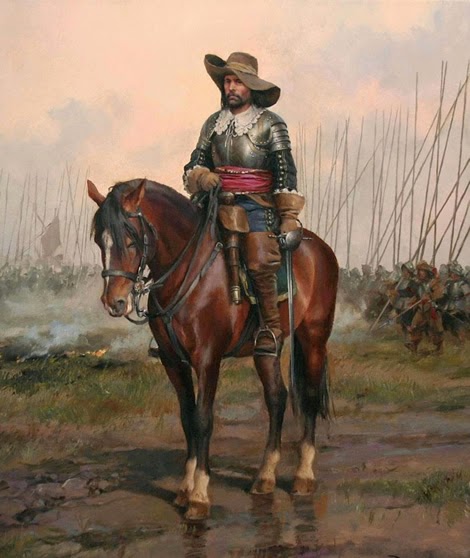 |
| Spanish Cavalry officer |
However, his army was no match for the Catholic League. Ferdinand secured assistance not only from Tilly, but also from Albrecht von Wallenstein, a Bohemian nobleman, who was a Lutheran by birth, then a converted Catholic, and now an ambitious mercenary with an eye on the Bohemian Crown lands.
After a series of military victories, Tilly and Wallenstein scattered the renegade German princes and compelled Christian IV to make peace in 1628. The Danish phase of the war ended again with Catholic victory. In 1629, Emperor Ferdinand issued the Edict of Restitution. The edict outlawed Calvinism, restored the former ecclesiastic territories to the Catholic Church, and restricted the right of legal appeal to the imperial diet by the Protestant princes.
The edict alienated the German Protestant princes. Meanwhile, the alliance between Spain and the Empire alarmed Lutheran king Gustavus Adolphus of Sweden (r. 1611–32) and King Louis XIII of France (r. 1610–43) and his chief minister, Armand-Jean du Plessis, duc and cardinal de Richelieu.
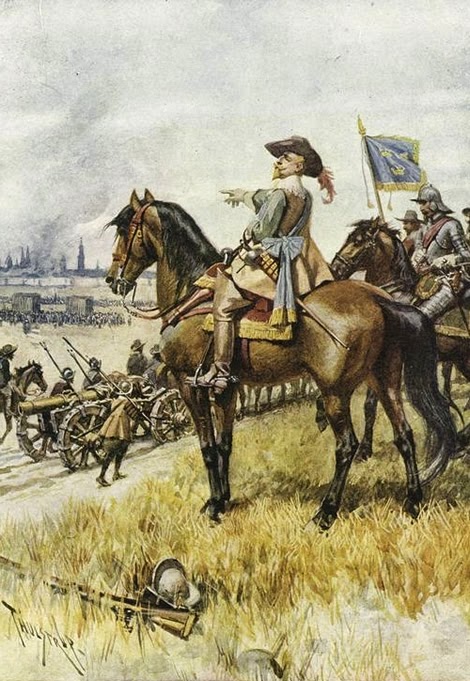 |
| Gustavus Adolphus of Sweden |
In the summer of 1630, the Swedish king, encouraged by the French Cardinal Richelieu and supported by the German Protestant princes, invaded Germany. After winning a few noteworthy battles in the early stage, he crushed Tilly’s Catholic League army in the battlefield at Breitenfeld in September of 1631.
Facing this defeat, Ferdinand was forced to turn to Wallenstein, who had been disgraced by the German Catholic powerhouses for his greedy and fast expansion of personal power. In November 1632, Wallenstein led his newly formed army, engaged the Swedish force at the Battle of Lutzen, and killed King Gustavus Adolphus on the battlefield. He then entered into a secret negotiation with the Swedes.
Because of his treachery, Ferdinand deprived him of his command and ordered his assassination in February 1634. The Swedish phase of the war ended with the Treaty of Prague of 1635, under which the Edict of Restitution was suspended and the Empire’s constitutional order was restored to pre-1618 conditions.
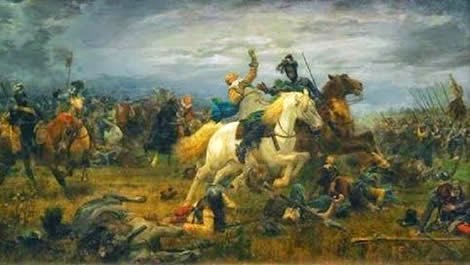 |
| 6 November 1632 - the Leu von Mitternacht, Gustavus Adolphus of Sweden, fell in the Battle of Lützen, 20 miles southwest of Leipzig |
Louis XIII and his cardinal became increasingly disturbed by any possible settlement that would give the Habsburgs in Europe opportunities to mount attacks against France—from Spain in the south, the Netherlands in the north, and from a number of Habsburg territories in the east. A few days before the Treaty of Prague was finalized, France declared war on Spain. In retaliation, Spain invaded France and defeated Sweden, the French ally, at the Battle of Wittstock in 1636.
Meanwhile, the German Imperial armies, now combining the Catholics and the Protestants allied with a new sense of national unity, marched into France, forcing the French back in Alsace and Lorraine, ravaging Burgundy and Champagne, and threatening Paris. The French, supported by Dutch Protestants, carried out a few successful counterattacks but could not gain a clear advantage over the enemy.
However, the deaths of Emperor Ferdinand (1637), Cardinal Richelieu (1642), and Louis XIII (1643) gradually slowed down the momentum of the war, and both the new emperor Ferdinand III and the new cardinal Mazarin under the child king Louis XIV began to work toward a peace settlement in 1643.
The German people, after suffering from three decades of havoc of war, political treacheries, religious bloodshed, and economic devastation, had to live miserably for another fives years to see peace.
The Peace of Westphalia was finally reached in October 1648, composed of a set of treaties among the enemies in the Thirty Years’ War. It reorganized Germany into a very loose confederation with a unified diet and unified army.
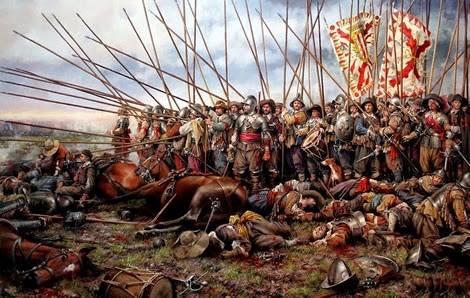 |
| Battle of Rocroi (1643) |
The emperor remained in place symbolically as feudal overlord for the purpose of recognizing and protecting “German Liberties.†The peace legalized Calvinism, gave it equal status as Catholicism and Lutheranism, and recognized the rights of religious minorities in the electorates and principalities.
In short, the peace treaties announced little new but redrew a constitutional framework, which would guarantee a decentralized Germany for another two centuries. However, the territorial changes defined in the treaties did help the rise of Prussia to challenge the traditional authority of Habsburg Austria in the Holy Roman Empire.
In Europe, the peace marked the rapid decline of support for prolonging the ongoing wars of religion, and fresh sentiments of national unity, national interest, and national defense would gradually reshape European peoples and states. It also helped promote transnational cooperation and alliance.
The immediate consequences of the Thirty Years’ War in European geopolitics were the isolation and decline of Spain and the rise of France as the dominant power till the French Revolution at the end of the 18th century.
- Peace Of Augsburg
Peace of Augsburg The Peace of Augsburg refers to a settlement between Charles V, Holy Roman Emperor, and the Lutheran princes that accorded Lutheran churches legal status in Germany. This settlement resolved the conflict on a state level but did not...
- Holy Roman Empire
Holy Roman Empire During the period of 1500 to 1750, the Holy Roman Empire grew to be a large political entity but faced serious problems that brought it close to the point of disintegration. The immense territory of the empire—over 300 states...
- Louis Xiv
Louis XIVLouis XIV was born in 1638, the son of King Louis XIII and his wife, Anne of Austria, from the Habsburg dynasty. Anne served as regent until Louis XIV began to govern in his own name in 1651. However, he was carefully guided by Cardinal Jules...
- War Of The Spanish Succession
War of the Spanish Succession The War of the Spanish Succession (1701–14) was a great European conflict fought over which claimant would assume the vacant throne of Spain. Throughout the 16th century, Spain had been ruled by the Habsburg dynasty,...
- Vasa Dynasty
Vasa DynastyThe Swedish Vasa ruled Sweden directly from 1523 to 1654, and their descendants ruled through the female line until 1818. They also were kings of Poland 1587–1668. The people of Sweden had long resented the Union of Kalmar that had...


